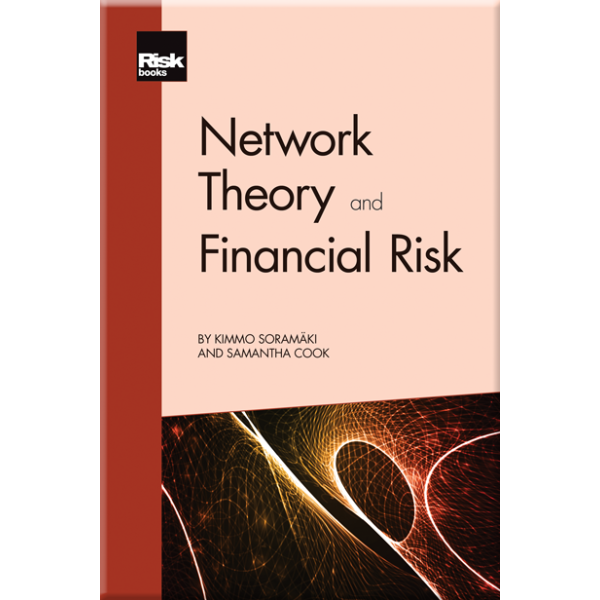Network Theory and Financial Risk
Almost all areas of financial risk have an underlying network that is relevant for measuring this risk. Understanding market risk involves understanding an entire network of assets; understanding liquidity risk involves understanding the network of liquidity flows; and understanding systemic risk necessitates understanding the network of counterparty exposures.
Network Theory and Financial Risk presents detailed examples of financial networks, which the reader can then put to use in practice analysing asset, payment, exposure, and supply chain networks for improved assessment and analysis of risk. Moreover, with an improved knowledge of network theory and the understanding that networks are literally everywhere, the reader may apply the concepts of network theory to new areas within and beyond finance.
Network Theory and Financial Risk is geared primarily towards practitioners, quantitative analysts, data scientists, economists and managers who have some knowledge of network theory and want to put that knowledge to use in analysing real network data. By making network analysis accessible, the book will also be of interest to researchers, professors, and students whose subject area contains network data.
"The Global Financial Crisis drove home the limitations of traditional statistical analysis to identify systemic risks stemming from structural weaknesses. Many observers have come to realize that economic and financial markets are examples of complex, highly interconnected, dynamic, adaptive systems. Network analysis is increasingly seen as an important tool for categorizing and tracking the key characteristics of such systems and for identifying areas of potential vulnerability. Network Theory and Financial Risk is a timely introduction to this essential topic. While not for the mathematically faint of heart, it will serve for many years to come as a vital resource for those seeking solid technical grounding in this area."
David M. Rowe, Ph.D.
President, David M. Rowe Risk Advisory and long-time Risk Analysis columnist for Risk magazine
"‘Financial networks are all around us’ - this is how the book starts. Is there a better way to express the powerfulness of the use of network theory to tackle financial problems? Network Theory and Financial Risk gives a comprehensive view on financial networks and takes the next step towards applications and visualization. Kimmo and Samantha have provided an exhaustive overview of financial networks techniques combined with many examples that bring the abstraction of the subject to practical understanding."
Tiziana Di Matteo
Professor of Econophysics, Department of Mathematics, King's College London
About the book
The financial crisis of 2007-2009 demonstrated the dangers of ignoring connections in complex systems for economics and finance: Lehman Brothers and AIG weren’t the biggest players in terms of size, but were very highly connected in the markets and their failures led to shocks across the financial system which are still being felt today.
As a result, applications of network theory are becoming ever more present in finance, with network analysis providing answers to questions where traditional analysis methods are weak; and also leading to improved models across wide types of risks. In fact, networks underlie virtually every type of risk, including liquidity, operational, insurance, and credit risk. However, while network approaches are very useful, understanding complex networks is not easy.
Network Theory and Financial Risk is a hands-on guide to analysing and modelling financial networks. Authors Kimmo Soramaki and Samantha Cook provide an in-depth introduction to network theory and examine general tools for network analysis, detailing coverage of four types of widely-occurring financial networks: payment systems, exposure networks, trade networks, and asset correlation networks.
| ISBN | 9781782722199 |
|---|---|
| Navision code | MNTF |
| Publication date | 25 Mar 2016 |
| Size | 155mmx235mm |
Kimmo Soramäki and Samantha Cook
Kimmo Soramäki is the Founder and CEO of Financial Network Analytics Ltd. (FNA), a software vendor specializing in mapping, modeling and visualizing interconnected financial systems. Before founding FNA in 2010, Kimmo worked for 15 years in policymaking and multidisciplinary research positions at several central banks, including the European Central Bank and the Federal Reserve Bank of New York. He is also the Editor in Chief of The Journal of Network Theory in Finance.
Dr. Samantha Cook is the Chief Scientist at FNA. Before joining FNA in 2012, she worked as a Quantitative Analyst at Google's Research Group in New York and as a Professor of Statistics at Universitat Pompeu Fabra in Barcelona. She has published in financial networks and statistics as well as psychology, economics, and public health, including work on Google Flu Trends. Sam holds a PhD in Statistics from Harvard University.
Chapter 1: Introduction to Financial Networks
Chapter 2: The Basics: Categorizing, Summarizing, and Generating Networks
Chapter 3: Identifying important nodes? Connectedness and Centrality
Chapter 4: Uncovering Latent Structure: Clustering and Community Detection
Chapter 5: Finding Hidden Links: Projection Networks
Chapter 6: Fast Insights: Visualizing Networks
Chapter 7: Financial Cartography: Network Layouts
Chapter 8: Brass Tacks: Complexity Reduction
Chapter 9: Market Risk: Asset Correlation Networks
Chapter 10: Liquidity and Operational Risk: Payment Networks
Chapter 11: Counterparty and Systemic Risk: Exposure Networks
Chapter 12: Supply Chain Risk: Trade Networks



